Development of a repressible mycobacterial promoter system based on two transcriptional repressors
- PMID: 20406773
- PMCID: PMC2896539
- DOI: 10.1093/nar/gkq235
Development of a repressible mycobacterial promoter system based on two transcriptional repressors
Abstract
Tightly regulated gene expression systems represent invaluable tools for studying gene function and for the validation of drug targets in bacteria. While several regulated bacterial promoters have been characterized, few of them have been successfully used in mycobacteria. In this article we describe the development of a novel repressible promoter system effective in both fast- and slow-growing mycobacteria based on two chromosomally encoded repressors, dependent on tetracycline (TetR) and pristinamycin (Pip), respectively. This uniqueness results in high versatility and stringency. Using this method we were able to obtain an ftsZ conditional mutant in Mycobacterium smegmatis and a fadD32 conditional mutant in Mycobacterium tuberculosis, confirming their essentiality for bacterial growth in vitro. This repressible promoter system could also be exploited to regulate gene expression during M. tuberculosis intracellular growth.
Figures

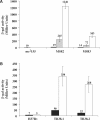
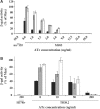

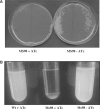
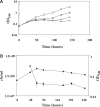


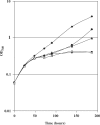
Similar articles
-
Controlling gene expression in mycobacteria with anhydrotetracycline and Tet repressor.Nucleic Acids Res. 2005 Feb 1;33(2):e21. doi: 10.1093/nar/gni013. Nucleic Acids Res. 2005. PMID: 15687379 Free PMC article.
-
Improving the stability of the TetR/Pip-OFF mycobacterial repressible promoter system.Sci Rep. 2019 Apr 8;9(1):5783. doi: 10.1038/s41598-019-42319-2. Sci Rep. 2019. PMID: 30962489 Free PMC article.
-
Pristinamycin-inducible gene regulation in mycobacteria.J Biotechnol. 2009 Mar 25;140(3-4):270-7. doi: 10.1016/j.jbiotec.2009.02.001. Epub 2009 Feb 13. J Biotechnol. 2009. PMID: 19428723
-
Improved tetracycline repressors for gene silencing in mycobacteria.Nucleic Acids Res. 2009 Apr;37(6):1778-88. doi: 10.1093/nar/gkp015. Epub 2009 Jan 27. Nucleic Acids Res. 2009. PMID: 19174563 Free PMC article.
-
Repressible Promoter System to Study Essential Genes in Mycobacteria.Methods Mol Biol. 2022;2377:317-332. doi: 10.1007/978-1-0716-1720-5_17. Methods Mol Biol. 2022. PMID: 34709624
Cited by
-
Pleiotropic effect of AccD5 and AccE5 depletion in acyl-coenzyme A carboxylase activity and in lipid biosynthesis in mycobacteria.PLoS One. 2014 Jun 20;9(6):e99853. doi: 10.1371/journal.pone.0099853. eCollection 2014. PLoS One. 2014. PMID: 24950047 Free PMC article.
-
FasR Regulates Fatty Acid Biosynthesis and Is Essential for Virulence of Mycobacterium tuberculosis.Front Microbiol. 2020 Oct 27;11:586285. doi: 10.3389/fmicb.2020.586285. eCollection 2020. Front Microbiol. 2020. PMID: 33193236 Free PMC article.
-
Gene and whole genome analyses reveal that the mycobacterial strain JS623 is not a member of the species Mycobacterium smegmatis.Microb Biotechnol. 2016 Mar;9(2):269-74. doi: 10.1111/1751-7915.12336. Epub 2016 Feb 1. Microb Biotechnol. 2016. PMID: 26834038 Free PMC article.
-
Essential Nucleoid Associated Protein mIHF (Rv1388) Controls Virulence and Housekeeping Genes in Mycobacterium tuberculosis.Sci Rep. 2018 Sep 21;8(1):14214. doi: 10.1038/s41598-018-32340-2. Sci Rep. 2018. PMID: 30242166 Free PMC article.
-
An IPTG Inducible Conditional Expression System for Mycobacteria.PLoS One. 2015 Aug 6;10(8):e0134562. doi: 10.1371/journal.pone.0134562. eCollection 2015. PLoS One. 2015. PMID: 26247874 Free PMC article.
References
-
- Vitoria M, Granich R, Gilks CF, Gunneberg C, Hosseini M, Were W, Raviglione M, De Cock KM. The global fight against HIV/AIDS, tuberculosis, and malaria: current status and future perspectives. Am. J. Clin. Pathol. 2009;131:844–848. - PubMed
-
- Wright A, Zignol M, Van Deun A, Falzon D, Gerdes SR, Feldman K, Hoffner S, Drobniewski F, Barrera L, van Soolingen D, et al. Epidemiology of antituberculosis drug resistance 2002-07: an updated analysis of the Global Project on Anti-Tuberculosis Drug Resistance Surveillance. Lancet. 2009;373:1861–1873. - PubMed
-
- Gandhi NR, Moll A, Sturm AW, Pawinski R, Govender T, Lalloo U, Zeller K, Andrews J, Friedland G. Extensively drug-resistant tuberculosis as a cause of death in patients co-infected with tuberculosis and HIV in a rural area of South Africa. Lancet. 2006;368:1575–1580. - PubMed
-
- Parish T, Mahenthiralingam E, Draper P, Davis EO, Colston MJ. Regulation of the inducible acetamidase gene of Mycobacterium smegmatis. Microbiology. 1997;143(Pt 7):2267–2276. - PubMed
-
- Triccas JA, Parish T, Britton WJ, Gicquel B. An inducible expression system permitting the efficient purification of a recombinant antigen from Mycobacterium smegmatis. FEMS Microbiol. Lett. 1998;167:151–156. - PubMed
Publication types
MeSH terms
Substances
LinkOut - more resources
Full Text Sources
Other Literature Sources

